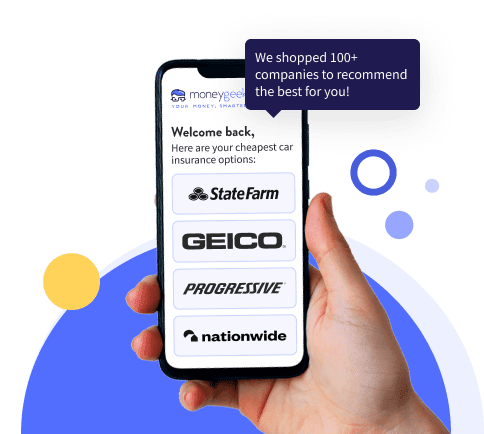Car insurance is a contract where you pay a premium and the insurer pays certain bills if you get into an accident. It also covers damage you cause to others and can protect your own car if you choose additional coverage. When you buy a policy, it will define what’s covered, how much the insurer pays and what costs you’re still responsible for.
Car Insurance Basics: Simple Definitions & Coverage Explained
Car insurance pays your bills when accidents happen. It covers the cost to fix damaged cars, pay medical expenses and legal costs when you're responsible for an accident.

Updated: November 13, 2025
Advertising & Editorial Disclosure
Car insurance protects you from expensive bills after an accident, covering injuries, repairs and legal costs so you’re not paying everything out of pocket.
Every state requires some level of coverage, and driving without it can lead to fines, license issues and higher premiums later.
The core coverages are liability, collision and comprehensive, and understanding what each one pays for makes it easier to choose the right policy.
Ensure you are getting the best rate for your insurance. Compare quotes from the top insurance companies.
Car Insurance: Basic Definition
Why Do You Need Car Insurance?
You need car insurance because:
- 1You Legally Can't Drive Without It
States require coverage to stay legal on the road, and skipping it leads to fines, suspensions and pricier premiums later.
- 2Accidents Are Expensive
Even a small fender-bender can cost thousands, and insurance steps in so you’re not paying everything yourself.
- 3It Protects What You Own
If you cause a major accident, insurance protects your savings, your car and even your future paychecks from legal claims.
Car Insurance Basics: Coverage Definitions
There are different types of car insurance coverage. You can have liability-only coverage or multiple types of coverage in your car insurance policy.
States require liability car insurance coverage to legally drive. Comprehensive and collision (also called full coverage) protect your own vehicle from damage. You can also add optional protections like uninsured motorist coverage and personal injury protection depending on your needs and your state's requirements. Learn the basics of each coverage type below.
- What it pays for: Injuries you cause to others and damage to their property. This includes medical bills, legal fees and repairs to anything you hit.
- How it works: Coverage is listed as numbers like 100/300/100, which show the max the insurer pays per person, per accident and for property damage.
- Why you need it: It’s required everywhere and protects you from expensive out-of-pocket costs after an at-fault accident.
- What it pays for: Repairs to your car after you hit another vehicle or object, or when another driver hits you.
- How it works: You pay your deductible, and insurance covers the rest up to your car’s value.
- Why you need it: It’s required for financed or leased cars and helpful if your car is worth more than you can replace on your own.
- What it pays for: Damage from non-crash events like theft, vandalism, falling objects, fire or severe weather.
- How it works: You pay your deductible, and insurance covers repairs or pays your car’s value if it’s totaled.
- Why you need it: It’s required with most loans and leases and protects your car from the most common non-accident risks.
Optional Coverage Definitions
To supplement your policy, you can add optional coverages.
Pays your medical bills, lost wages and rehabilitation costs after an accident, no matter who caused it. Required in some states and typically costs a few hundred dollars yearly.
Pays your medical bills and car repairs when someone without insurance (or without enough insurance) hits you. About one in eight drivers has no insurance, making this coverage important protection.
Gap insurance covers the difference between your car's actual cash value and your remaining loan balance. This coverage is important for leased vehicles and new car purchases where the loan may be more than the value of the car.
Basic Car Insurance Terms You Need to Know
Understanding a few core terms makes it easier to read your policy and know what you're paying for.
Deductible | What you pay out of pocket on a claim before insurance covers the rest. |
Liability | Your legal responsibility for an accident you cause; liability insurance pays the other person’s bills. |
Coverage Limits | The maximum amount your insurer will pay for a covered claim. |
Quote | An estimate of your premium based on your driving record, location and vehicle. |
Claim | A request you file for your insurer to pay for repairs or medical bills after an accident. |
Claims Adjuster | The person who assesses the damage and determines what the insurer pays. |
Underwriting | The insurer’s process for reviewing your risk and setting your premium. |
Actual Cash Value (ACV) | Your car’s current market value, used to calculate payouts if your car is totaled. |
At-Fault | The driver determined to have caused an accident. |
No-Fault | A system in some states where your own insurer pays your medical bills, regardless of who caused the accident. |
Basic Car Insurance: Bottom Line
Car insurance protects you from the high costs of accidents, covering injuries, repairs and legal bills. Liability coverage is required everywhere, and adding collision and comprehensive protects your own car. Once you understand what each coverage does, choosing a policy becomes simple. Compare quotes and pick the best car insurance policy that fits your needs and budget.
Ensure you are getting the best rate for your insurance. Compare quotes from the top insurance companies.
Basic Car Insurance: FAQ
Here are basic answers to the most commonly asked questions about car insurance:
What does car insurance actually cover?
Car insurance covers injuries, property damage and legal costs when you cause an accident. If you add collision and comprehensive, it also pays to repair or replace your own car after crashes, theft, weather damage and other non-driving incidents.
How much does car insurance cost?
The national average cost of car insurance is $80 per month for minimum coverage and $158 per month for full coverage. Your actual cost depends on your age, location, driving record, credit score and the car you drive. Compare costs between insureres to find the cheapest car insurance companies.
Why do car insurance rates vary so much?
Insurers look at your driving record, where you live, how often you drive, your credit score and your vehicle’s value to predict your risk. Higher risk means higher rates, which is why young drivers and people with tickets often pay more.
What car insurance coverages do I actually need?
You need at least your state’s minimum liability coverage to drive legally. Most drivers should choose higher liability limits and add collision and comprehensive to protect their own car from crashes, theft and weather damage.
What happens after a car accident?
You file a claim with your insurer, and a claims adjuster reviews the damage and decides what the company will pay. If you have the right coverages, your insurance helps pay for repairs, medical bills and legal expenses.
Car Insurance Basics: Related Articles
About Mark Fitzpatrick

Mark Fitzpatrick, a Licensed Property and Casualty Insurance Producer, is MoneyGeek's resident Personal Finance Expert. With over five years of experience analyzing the insurance market, he conducts original research and creates tailored content for all types of buyers. His insights have been featured in publications like CNBC, NBC News and Mashable.
Fitzpatrick holds a master’s degree in economics and international relations from Johns Hopkins University and a bachelor’s degree from Boston College. He's also a five-time Jeopardy champion!
He writes about economics and insurance, breaking down complex topics so people know what they're buying.
sources
- Insurance Information Institute. "Background on: Compulsory Auto/Uninsured Motorists." Accessed June 20, 2025.






